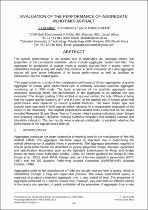JavaScript is disabled for your browser. Some features of this site may not work without it.
- ResearchSpace
- →
- Research Publications/Outputs
- →
- Conference Publications
- →
- View Item
| dc.contributor.author |
Komba, Julius J

|
|
| dc.contributor.author |
O'Connell, Johannes S

|
|
| dc.contributor.author |
Paige-Green, P

|
|
| dc.date.accessioned | 2014-08-27T05:52:36Z | |
| dc.date.available | 2014-08-27T05:52:36Z | |
| dc.date.issued | 2014-07 | |
| dc.identifier.citation | Komba, J.J, O’Connell, J and Paige-Green, P. 2014. Evaluation of the performance of aggregate in hot-mix asphalt. In: 33rd Annual Southern Africa Transportation Conference, Pretoria, South Africa, 7-10 July 2014 | en_US |
| dc.identifier.isbn | 978-1-920017-61-3 | |
| dc.identifier.uri | http://hdl.handle.net/10204/7634 | |
| dc.description | 33rd Annual Southern Africa Transportation Conference, Pretoria, South Africa, 7-10 July 2014 | en_US |
| dc.description.abstract | The overall performance of an asphalt mix is dependent on, amongst others, the properties of the constituent materials, which include aggregate, binder and filler. The aggregate for production of asphalt mixes is usually sourced from a quarry, which is established through a long and expensive process. A quick evaluation of a new aggregate source will give some indication of its future performance as well as facilitate its introduction into the market place. This paper presents a study of the comparative performance of two aggregates; a granite aggregate of known good performance and a relatively unknown quartzite aggregate containing up to 30% shale. The basic properties of the quartzite aggregate were assessed; following which, the performance of the aggregate in an asphalt mix was evaluated. The design grading of the asphalt mixes was similar; the only difference being that the coarse granite fractions (6.7 and 9.5 mm) of the asphalt mix of known good field performance were replaced by coarse quartzite fractions. The same binder type and crusher sand was used in both asphalt mixes, allowing for a comparative evaluation of the mixes in the laboratory. The asphalt performance-related tests conducted on the mixes included Repeated Simple Shear Test at Constant Height (rutting indicator), beam fatigue test (cracking indicator), dynamic modulus (stiffness indicator) and modified Lottman test (durability indicator). The test results were analysed statistically, to establish whether the performance of the asphalt mixes differed. | en_US |
| dc.language.iso | en | en_US |
| dc.relation.ispartofseries | Workflow;13342 | |
| dc.subject | Hot-Mix Asphalt | en_US |
| dc.subject | HMA | en_US |
| dc.subject | Aggregates | en_US |
| dc.subject | Granite aggregate | en_US |
| dc.subject | Quartzite aggregate | en_US |
| dc.title | Evaluation of the performance of aggregate in hot-mix asphalt | en_US |
| dc.type | Conference Presentation | en_US |
| dc.identifier.apacitation | Komba, J. J., O'Connell, J. S., & Paige-Green, P. (2014). Evaluation of the performance of aggregate in hot-mix asphalt. http://hdl.handle.net/10204/7634 | en_ZA |
| dc.identifier.chicagocitation | Komba, Julius J, Johannes S O'Connell, and P Paige-Green. "Evaluation of the performance of aggregate in hot-mix asphalt." (2014): http://hdl.handle.net/10204/7634 | en_ZA |
| dc.identifier.vancouvercitation | Komba JJ, O'Connell JS, Paige-Green P, Evaluation of the performance of aggregate in hot-mix asphalt; 2014. http://hdl.handle.net/10204/7634 . | en_ZA |
| dc.identifier.ris | TY - Conference Presentation AU - Komba, Julius J AU - O'Connell, Johannes S AU - Paige-Green, P AB - The overall performance of an asphalt mix is dependent on, amongst others, the properties of the constituent materials, which include aggregate, binder and filler. The aggregate for production of asphalt mixes is usually sourced from a quarry, which is established through a long and expensive process. A quick evaluation of a new aggregate source will give some indication of its future performance as well as facilitate its introduction into the market place. This paper presents a study of the comparative performance of two aggregates; a granite aggregate of known good performance and a relatively unknown quartzite aggregate containing up to 30% shale. The basic properties of the quartzite aggregate were assessed; following which, the performance of the aggregate in an asphalt mix was evaluated. The design grading of the asphalt mixes was similar; the only difference being that the coarse granite fractions (6.7 and 9.5 mm) of the asphalt mix of known good field performance were replaced by coarse quartzite fractions. The same binder type and crusher sand was used in both asphalt mixes, allowing for a comparative evaluation of the mixes in the laboratory. The asphalt performance-related tests conducted on the mixes included Repeated Simple Shear Test at Constant Height (rutting indicator), beam fatigue test (cracking indicator), dynamic modulus (stiffness indicator) and modified Lottman test (durability indicator). The test results were analysed statistically, to establish whether the performance of the asphalt mixes differed. DA - 2014-07 DB - ResearchSpace DP - CSIR KW - Hot-Mix Asphalt KW - HMA KW - Aggregates KW - Granite aggregate KW - Quartzite aggregate LK - https://researchspace.csir.co.za PY - 2014 SM - 978-1-920017-61-3 T1 - Evaluation of the performance of aggregate in hot-mix asphalt TI - Evaluation of the performance of aggregate in hot-mix asphalt UR - http://hdl.handle.net/10204/7634 ER - | en_ZA |






